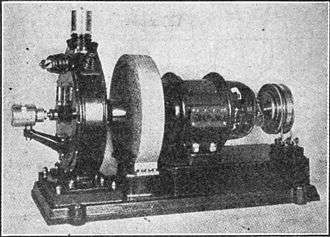Beat frequency oscillator
In a radio receiver, a beat frequency oscillator or BFO , is a dedicated oscillator used to create an audio frequency signal from Morse code radiotelegraphy (CW) transmissions to make them audible. The signal from the BFO is mixed with the intermediate frequency signal to create a heterodyne or beat frequency which is heard as a tone in the speaker. BFOs are also used to demodulate single-sideband (SSB) signals, making them intelligible, by essentially replacing the suppressed carrier. BFOs are usually included in communications receivers designed for short wave listeners and amateur radio stations, which often receive CW and SSB signals.
The beat frequency oscillator was invented in 1901 by Canadian engineer Reginald Fessenden, what he called the "heterodyne" receiver was the first application of the heterodyne principle.
Overview
In continuous wave (CW) radio transmission, also called radiotelegraphy or on-off keying and designated by the International Telecommunication Union as emission type A1A, information is transmitted by pulses of unmodulated radio carrier wave which spell out text messages in Morse code. The different length pulses of carrier, called "dots" and "dashes", are produced by the operator switching the transmitter on and off rapidly using a switch called a telegraph key. This was the first type of radio transmission, and during the early 20th century was widely used for both private person-to-person messages and commercial telegram traffic. With the rise of other types of modulation its use has declined, and CW is now only used for personal hobbyist messages by radio amateurs and is becoming obsolete.
Since the pulses of carrier have no audio modulation, in an AM radio receiver a CW signal simply sounds like silence.[1] In order to make the carrier pulses audible in the receiver, a beat frequency oscillator is used. The BFO is a radio frequency electronic oscillator that generates a constant sine wave at a frequency fBFO that is offset from the intermediate frequency fIF of the receiver. This signal is mixed with the IF before the receiver's second detector (demodulator). In the detector the two frequencies subtract, and a beat frequency (heterodyne) in the audio range at the difference between the frequencies is produced: faudio = |fIF - fBFO| which sounds like a tone in the receiver's speaker. During the pulses of carrier the beat frequency is generated, while between the pulses there is no carrier so no tone is produced. Thus the BFO makes "dots" and "dashes" of the Morse code signal audible, sounding like different length "beeps" in the speaker. A listener who knows Morse code can decode this signal to get the text message.
The first BFOs, used in early tuned radio frequency (TRF) receivers in the 1910s-1920s, beat with the carrier frequency of the station, so they had to be tunable.
Since in a superheterodyne receiver the different frequencies of the different stations are all translated to the same intermediate frequency by the mixer, modern BFOs can have a constant frequency. There must be a switch to turn off the BFO when it is not needed, when receiving other types of signals. There is also usually a knob on the front panel to adjust the frequency of the BFO, to change the tone produced.
Example


A receiver is tuned to a Morse code signal, and the receiver's intermediate frequency (IF) is fIF = 45000 Hz. That means the dots and dashes have become pulses of a 45000 Hz signal, which is inaudible.
To make them audible, the frequency needs to be shifted into the audio range, for instance faudio = 1000 Hz. To achieve that, the desired BFO frequency is fBFO = 44000 or 46000 Hz.
When the signal at frequency fIF is mixed with the BFO frequency in the detector stage of the receiver, this creates two other frequencies or heterodynes: |fIF − fBFO|, and |fIF + fBFO|. The difference frequency, faudio = |fIF − fBFO| = 1000 Hz, is also known as the beat frequency.
The other, the sum frequency, (Fif + Fbfo) = 89000 Hz, is unneeded. It can be removed by a lowpass filter, such as the radio's speaker, which cannot vibrate at such a high frequency.
fBFO = 46000 Hz also produces the desired 1000 Hz beat frequency and could be used instead.
Notes
By varying the BFO frequency around 44000 Hz, the listener can vary the output audio frequency; this is useful to correct for small differences between the tuning of the transmitter and the receiver, particularly useful when tuning in single sideband voice. The waveform produced by the BFO beats against the IF signal in the mixer stage of the receiver. Any drift of the local oscillator or the beat-frequency oscillator will affect the pitch of the received audio, so stable oscillators are used.[2]
For a radio signal with more bandwidth than Morse code, low-side injection preserves the relative order of the frequency components. High-side injection reverses their order, which is often desirable to counteract a previous reversal in the radio receiver.
References
- ↑ Because the carrier pulses blocked out the normal static atmospheric "hiss" in the receiver, CW signals could sometimes be heard without a BFO as "pulses" of silence in the atmospherics. However this was not a reliable method of reception
- ↑ Paul Horowitz, Winfield Hill "The Art of Electronics 2nd Ed." Cambridge University Press 1989 ISBN 0-521-37095-7, page 898
- "Radiotelephone", NEETS, Module 17--Radio-Frequency Communication Principles. Integrated Publishing, Electrical Engineering Training Series.
- "Ceramic Filter Beat Frequency Oscillator", Naturemagics.com.
- "Voice Modes", ARRL.